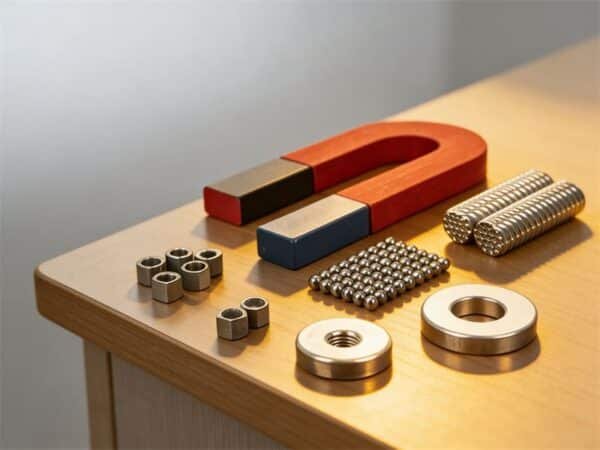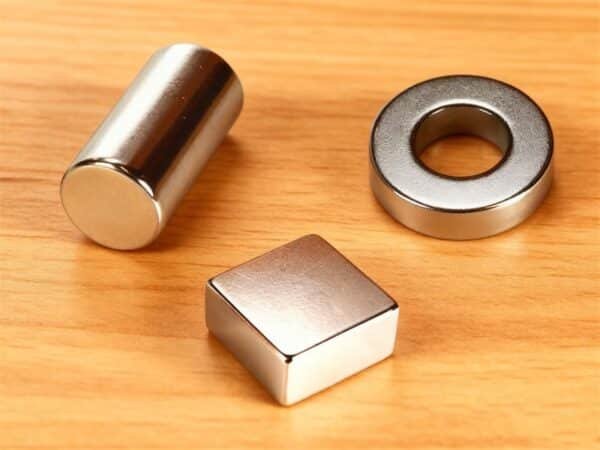Permanent magnet motors use permanent magnets to generate the magnetic field of the motor, without the need for excitation coils or excitation current. Compared with traditional electric excitation motors, it has significant advantages such as high efficiency and simple structure.
The applications of permanent magnet motors are extremely wide, covering almost every field of aerospace, national defense, industrial and agricultural production, and daily life. With the development of high-performance permanent magnet materials and the rapid development of control technology, the application of permanent magnet motors will become more extensive. Today I will take you to understand the impact of the performance of permanent magnet motors and permanent magnet materials on the motor.
Principle And Structure Of Permanent Magnet Motor
Everyone knows that there are many types of motors, but the basic principles are the application of electromagnetism and electromagnetic induction to realize the conversion of electrical energy and kinetic energy. If you want to know more about the basic principles and structure of motors, you can click to view the basic principles and basic structure. Today, we will take permanent magnet DC motor and permanent magnet synchronous motor as examples to give you a brief introduction to permanent magnet motor.
1. Permanent Magnet DC Motor
The working principle and structure of the permanent magnet DC motor are similar to the ordinary DC motor, except that the permanent magnet pole is used to replace the magnetic pole excited by the current. The commutation method can be divided into brush motor and brushless motor. The electronic commutation.
Taking a DC brush motor as an example, the magnetic poles of the permanent magnets are arranged on the same circumference, and the blue lines of the magnetic force represent the magnetic circuit of the motor.
The rotor of the permanent magnet brushed DC motor is composed of the rotor core, rotor winding, commutator, and rotating shaft, which is the same as the rotor of a common DC motor. Insert the rotor and brush assembly into the stator to form a permanent magnet DC motor.
Small and medium power permanent magnet DC motors are widely used in electric bicycles, electric motorcycles and scooters.
2. Permanent Magnet Synchronous Motors
In recent years, permanent magnet synchronous motors have developed rapidly, which are characterized by high power factor and high efficiency. They have gradually replaced the commonly used AC asynchronous motors on many occasions. Among them, the asynchronous starting permanent magnet synchronous motors have excellent performance, and they are very promising energy-saving motors.
The stator structure and working principle of the permanent magnet synchronous motors are the same as the AC asynchronous motors. The difference from the ordinary asynchronous motor lies in the rotor structure. The rotor is equipped with permanent magnet poles, and the permanent magnets are arranged in various positions in the rotor.
The development of permanent magnet motors is closely related to the development of permanent magnet materials.
The first motor in the world that appeared in the 1920s was a permanent magnet motor that generated an excitation magnetic field from permanent magnets. However, the permanent magnet material used at the time was natural magnetite (Fe3O4), and the magnetic energy density was very low. The motor made of it was bulky and was soon replaced by an electric excitation motor.
With the rapid development of various motors and the invention of current magnetizers, people have conducted in-depth research on the mechanism, composition, and manufacturing technology of permanent magnetic materials, and have successively discovered a variety of permanent magnetic materials such as carbon steel, tungsten steel, and cobalt steel.
Especially the aluminum-nickel-cobalt permanent magnets that appeared in the 1930s and the ferrite permanent magnets that appeared in the 1950s have greatly improved their magnetic properties, and various micro and small motors have used permanent magnets for excitation. However, the coercive force of AlNiCo permanent magnets is low, and the remanence density of ferrite permanent magnets is not high, which limits their application range in motors.
Until the 1960s and 1980s, samarium-cobalt permanent magnets and neodymium-iron-boron permanent magnet materials came out in succession. Their high residual magnetic density, high coercivity, high magnetic energy product, and linear demagnetization curve are particularly suitable for excellent magnetic properties. Manufacturing motors, so the development of permanent magnet motors has entered a new historical period.
Relationship Between Magnetic Steel Performance And Motor Performance
1. Influence Of Remanence
For DC motors, under the same winding parameters and test conditions, the higher the remanence, the lower the no-load speed, and the smaller the no-load current; the greater the maximum torque, the higher the efficiency of the highest efficiency point.
In the actual test, the level of no-load speed and the size of the maximum torque is generally used to judge the remanence standard of the magnetic steel.
For the same winding parameters and electrical parameters, the reason why the higher the remanence is, the lower the no-load speed and the smaller the no-load current is, because the running motor has a sufficient reverse sense at a relatively low speed The generated voltage reduces the algebraic sum of the electromotive force applied to the winding.
2. The Influence Of Coercivity
During the operation of the motor, there is always the influence of temperature and reverse demagnetization. From the perspective of motor design, the higher the coercive force, the smaller the thickness direction of the magnet, and the smaller the coercive force, the greater the thickness direction of the magnet. But after the magnetic steel exceeds a certain coercive force, it is useless, because other components of the motor can not work stably at that temperature. The coercive force is sufficient to meet the demand. Taking the demand under the recommended experimental conditions as the standard, there is no need to waste resources.
3. The Influence Of Squareness
The squareness only affects the straightness of the efficiency curve of the motor performance test. Although the straightness of the motor efficiency curve has not been listed as an important index standard, it is very important for the continuous distance of the hub motor under natural road conditions. important. Because of different road conditions, the motor cannot always work at the maximum efficiency point, which is one of the reasons why the maximum efficiency of some motors is not high and the running distance is far away. For a good hub motor, not only the maximum efficiency should be high, but also the efficiency curve should be as level as possible. The lower the slope of the efficiency reduction, the better. As the market, technology and standards of in-wheel motors mature, this will gradually become an important standard.
4. The Impact Of Performance Consistency
Inconsistent residual magnetism: Even the individual with particularly high performance is not good. Due to the inconsistency of the magnetic flux in each unidirectional magnetic field section, the torque is asymmetric and vibration occurs.
Coercive force inconsistency: In particular, the coercive force of individual products is too low, it is easy to produce reverse demagnetization, resulting in the inconsistency of the magnetic flux of each magnetic steel and the motor vibration. This effect is more significant for brushless motors.
Influence Of Shape And Tolerance Of Magnetic Steel On Motor Performance
1. The Influence Of Magnet Thickness
In the case of fixed inner or outer magnetic coils, when the thickness increases, the air gap decreases and the effective magnetic flux increases. The obvious performance is that the same residual magnetism reduces the no-load speed, the no-load current decreases, and the maximum efficiency of the motor improve. However, there are also disadvantages, such as increased commutation vibration of the motor, and the efficiency curve of the motor becomes relatively steep. Therefore, the thickness of the motor magnet should be as uniform as possible to reduce vibration.
2. The Effect Of Magnet Width
For close-packed brushless motor magnets, the total cumulative gap cannot exceed 0.5 mm. If it is too small, it cannot be installed. If it is too small, the motor vibration and efficiency will be reduced. This is because the position and magnetic of the Hall element that measures the magnet position The actual position of the steel does not correspond, and the consistency of the width must be guaranteed, otherwise the efficiency of the motor is low and the vibration is large.
For brushed motors, there is a certain gap between the magnetic steel, which is reserved for the mechanical commutation transition zone. Although there is a gap, most manufacturers have strict magnetic steel installation procedures to ensure the installation accuracy in order to ensure the installation position of the motor magnetic steel. If the width of the magnetic steel is exceeded, it will not be installed; if the width of the magnetic steel is too small, it will result in misalignment of the magnetic steel, increase the vibration of the motor, and reduce the efficiency.
3. Magnet Chamfer Size And The Effect Of Non-Chamfer
Without chamfering, the rate of change of the magnetic field at the edge of the motor’s magnetic field is large, causing pulse pulsation of the motor. The larger the chamfer, the smaller the vibration. However, chamfering generally has a certain loss of magnetic flux. For some specifications, when the chamfering reaches 0.8, the magnetic flux loss is 0.5 ~ 1.5%. When the residual magnetism of the brushed motor is low, appropriately reducing the size of the chamfer is helpful to compensate for the residual magnetism, but the pulsation of the motor increases. In general, when the remanence is low, the tolerance in the length direction can be enlarged appropriately, which can increase the effective magnetic flux to a certain extent, so that the performance of the motor is basically unchanged.

I’m Ben, with over 10 years in the permanent magnet industry. Since 2019, I’ve been with Osenc, specializing in custom NdFeB magnet shapes, magnetic accessories, and assemblies. Leveraging deep magnetic expertise and trusted factory resources, we offer one-stop solutions—from material selection and design to testing and production—streamlining communication, accelerating development, and ensuring quality while reducing costs through flexible resource integration.


